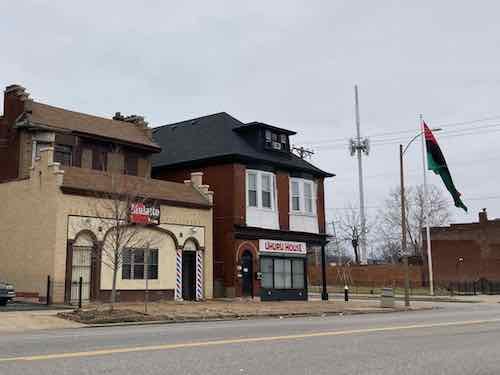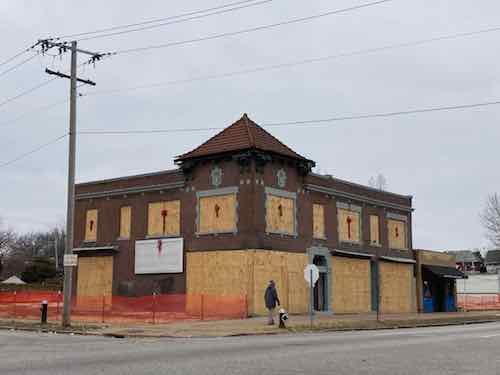Is Gentrification Encroaching on the O’Fallon Neighborhood?
Today is Election Day in St. Louis, odd-numbered wards will vote aldermen, plus mayor and comptroller. In the 21st ward six candidates are running for alderman. The top two in today’s nonpartisan primary will face each other in the April general election.
Different visions for the future of the O’Fallon Neighborhood will potentially play a role in the minds of voters in the 3rd & 21st wards. In the 21st ward there are six candidates — the highest number of any race today.
In early January I posted about a development proposal supported by the incumbent, see Initial Thoughts On Proposed ‘City District’ In North St. Louis. Since then I drove the area again to get better photographs. It was then I got to see actual results of another development effort in the same area.
Led by Ona Zené Yeshitela, President of the African People’s Education and Defense Fund (APEDF) and Black Star Industries (BSI), the Black Power Blueprint was launched in 2017 on the North Side of St. Louis, the most impoverished area of the city.
The Black Power Blueprint is buying abandoned, dilapidated buildings, initiating a rapid process of restoration or demolition and re-allocation of land to create community-generated, self-reliance programs that uplift the residents and engage them socially, politically and economically in the future of our community.
In three years APEDF and BSI have raised more than $300,000 in funds primarily from crowd-funding, webinars, Uhuru Pies and Uhuru Furniture sales, countless donors and in-kind services and contributions.
This outpouring of support has enabled the Black Power Blueprint to transform a community—not just with land and buildings, but with a sense of pride and a vision for a prosperous future once again. (Black Power Blueprint)

I missed a news story about this effort last November:
According to city property records, the groups have purchased half a dozen properties along West Florissant Avenue between Grand Boulevard and O’Fallon Park and applied for more than $269,000 in building and demolition permits. Home base is the 9,000-square-foot Uhuru House, an event space named after the word “freedom” in Swahili. There are two other houses like it, one in Oakland, California, and St. Petersburg, Florida, all part of the international Uhuru Movement, which strives to unite Africans from the diaspora caused by the global slave trade. (Post-Dispatch)
I very happy to see such an effort, so I went through their entire website. On one page the group lists the grim reality many blacks face in St. Louis, but one stood out to me as a good issue to explore:
Black residents of North St. Louis face rapidly encroaching gentrification, with higher rents and property taxes, that is forcing thousands further out into the county and beyond.
I don’t doubt rents are increasing, and we know blacks have been leaving north St. Louis for years. But “rapidly encroaching gentrification”?
First, we need to define gentrification. In 2017 one expert broke down gentrification into four types: expansive, concentrated, limited, and nascent.

St. Louis is considered concentrated:
Concentrated Gentrification
Best examples: Chicago, Philadelphia and Washington, D.C.
Here, the cities share the same type of older layout as the cities above, but have had larger (relative) black populations. This is where you see that larger parts of such cities have been “written off” by many residents. In each case, gentrification sprouted usually from one area that was a last bastion of white affluent residents (Chicago’s North Side, Northwest D.C. or the area around the University of Pennsylvania in Philly) and spread outward from there. Although most large cities have vast inequality, it’s most evident in these cities because they tend to be racially, economically and socially divided. (Huffington Post)
The argument is larger 1970 black populations meant whites had written off areas considered black. In St. Louis that generally means north of Delmar. Concentrated gentrification occurs as affluent white areas get so expensive buyers look to adjacent areas.
In St. Louis we’ve seen this along the central corridor— that wide swath of the region westward from the central business district. McRee Town was razed for Botanical Heights. Forest Park Southeast has changed dramatically over the last 30 years with the The Grove district.
So yes, gentrification does happen in St. Louis. However, Delmar has remained a formidable barrier separating the central corridor from north St. Louis. The O’Fallon neighborhood is a long way from the central corridor. I can’t see it gentrifying unless the neighborhoods in between gentrify first.
When census numbers are released I think we’ll continue to see population declines in north St. Louis neighborhoods. Lots of problems to address, gentrification isn’t one of them.
— Steve Patterson